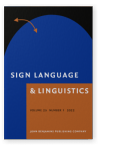Vol. 25:1 (2022) ► pp.58–91
On question words in Czech Sign Language
This paper investigates content questions and the paradigm of question words in Czech Sign Language (český znakový jazyk – ČZJ). While this topic has been investigated for a fair number of other sign languages, a comprehensive study for ČZJ is still missing. Our aim is to fill this gap. In the absence of a representative corpus for ČZJ, we use data from the most extensive electronic dictionary database (Dictio), developed at the Masaryk University in Brno. We offer a basic description of the ČZJ interrogative strategies for content questions. In doing so, we also situate the language within the typology of sign language interrogatives: we classify ČZJ as a language with a rich paradigm of question words, and we identify the basic syntactic position of question words as sentence-final. Furthermore, we outline three morphological types of ČZJ question words: simple, complex, and derived.
Article outline
- 1.Introduction
- 2.Data and methodology
- 2.1The Dictio platform
- 2.2Sessions with the consultant
- 3.Basic facts about content questions in ČZJ
- 3.1Sentential position of question words
- 3.2Question word paradigm
- 4.Morphological types of ČZJ question words
- 4.1Simple question words
- 4.2Complex question words
- 4.3Derived question words
- 5.Conclusion
- Acknowledgements
- Notes
-
References
